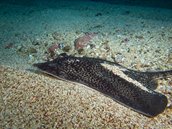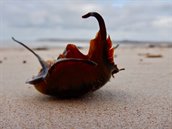Sharks, rays and offshore power cables
Do elasmobranchs get a buzz from electromagnetic fields in offshore wind farms?
Cables in offshore wind farms generate electromagnetic fields (EMF). Recently, WaterProof measured EMF near export cables during a validation survey, commissioned by Wozep. The construction of more offshore wind farms will require more and stronger cables and so we need a clearer picture of the potential effects and mechanisms involved, especially with regard to sharks and rays because they are particularly susceptible. The Dutch Science Council (NWO) has now approved the ElasmoPower project, which will hopefully provide answers to some of the questions facing Wozep.

Photo 1: Thornback Ray (source: Stuttershock).
The five-year ElasmoPower project consists of six steps. The first step consists of measuring actual EMF levels in different conditions. The aim is to collect the first data in the autumn of 2020. The study will look at how wind levels and power levels through the cable affect EMFs, as well as the impact of different burial depths.
The second step will be to use the acquired data for dose-response studies in the laboratory with different species of native sharks and rays: the thornback ray (Raja Clavata), blond ray (Raja brachyura) and small-spotted catshark (Scyliorhinus canicula) (subject to availability). The aim will be to see how EMFs affect the behaviour of these fish (such as changes in foraging behaviour or swimming depth). The selected species will be the same as in other elasmobranch research projects such as Innorays and the Life-IP. Combining different datasets from all the projects will teach us more about the possible link between behaviour and potential effects.
The aim of the third step will be to link the laboratory and field results. That will include the use of Baited Remote Underwater Video Systems (BRUVs) and eDNA analysis. It is hoped that these techniques will show whether electromagnetic fields affect the relative abundance and behaviour of elasmobranchs in the North Sea.
The study will also look at the link between EMFs and the presence of prey species, as well as whether elasmobranchs deposit their eggs on man-made structures such as wind turbine foundations. This fourth step will involve using molecular techniques such as DNA metabarcoding for benthic organisms, eDNA analysis for mobile organisms, and field video surveys in ffshore wind farms using remotely operated vehicles.

Image 1: Visual representation of the steps of ElasmoPower (source: ©Joost Fluitsema).
All the information obtained will be used to develop models in the fifth step with the aim of determining the impact and so to develop recommendations about potential mitigation measures.
Given the gaps in our knowledge about how EMFs affect marine fauna, the knowledge developed in this study will be useful for other species groups and other seas. Step six of the programme will target the effective dissemination of the results so that they can be used by national and international stakeholders such as government authorities, industry, NGOs and scientists.

Photo 2: Egg case of a ray (source: Stuttershock).
ElasmoPower brings together Wageningen University and Research, Naturalis, TenneT, Witteveen+Bos, the North Sea Foundation and RWS Wozep. The parties involved in the research are WaterProof, Bureau Waardenburg, Cefas, TNO and Flanders Marine Institute (VLIZ).
You can find more information about the ElasmoPower project in the IDON newsletter here.